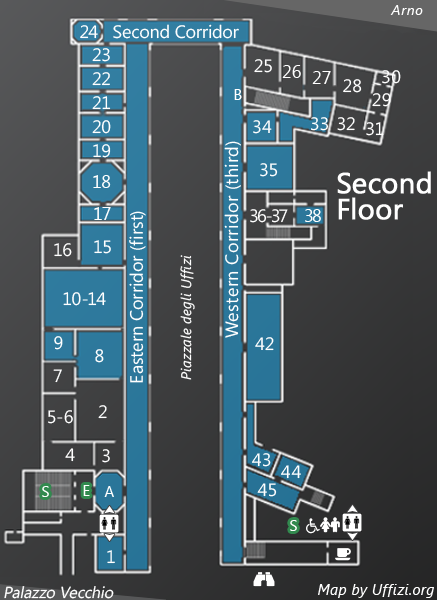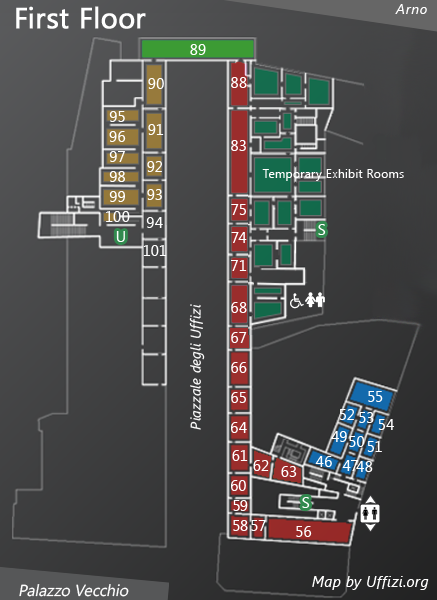How the Uffizi Museum is Set Up
The Uffizi is currently undergoing a lot of changes – the project “New Uffizi” is underway to modernize the museum and to make it easier to visit and better for the conservation of the treasures inside. Works of art are being moved around and new sections are being opened on the first floor, while rooms on the second floor are starting to be renovated. Knowing all of this ahead of time will ensure your visit goes off well!
Museum layout
The museum is spread out over 3 floors. The start of your visit starts on the top floor, called the 2nd floor by Italian standards. The main means of getting to the start of the museum and this top floor is a grand staircase that dates back to the 1500s to the time of the Medici when the Uffizi was built. There are a few elevators/lifts but these are small and are reserved for anyone who cannot use the stairs. Check out services for more details.
The ground floor is where you find the ticket office and main entrances into the museum along the U-shaped palace. As you enter the museum, you’ll find a well supplied bookstore with art history books, souvenirs, children’s books and much more to the right, in the opposite direction of the entrance into the museum. You’ll pass through the bookstore on your exit out of the museum so stop here at the beginning only if you wish to buy a museum guide to the works of art to use during your visit.
The first floor has several interesting halls, including the “Cabinet of Prints and Drawings” within the Uffizi collection (some are on display on a rotational basis in the vestibule to the Cabinet, stop for a quick look) but you essentially will see the rest of the collection only after you’ve visited the main collection on the second floor. For now, keep on heading on to the second floor to start your visit.
On the second floor you’ll find the main and some of the most interesting halls in the museum. The 45 halls on this floor display works of art from the 13th to the 18th centuries with the many sculptures from antiquity from the Medici collections displayed in the three corridors that line the interior of the U-shaped building. Many of the most important works of art you’ve come to see at the Uffizi are on this floor!
At the end of the second floor, above the Loggia dei Lanzi, you’ll find a cafe that offers visitors a chance for a snack or drink with an extraordinary view of Palazzo Vecchio and the rest of the historical center of Florence. Stop to enjoy the view! From here, you head back down to the first floor along a modern staircase to visit the recently modernized sections of the museum, often called by the color on the walls: Blue and Red in this first wing where you’ll find works by 17th and 18th century foreign painters and 15th century Tuscans, as well as marble sculptures from Hellenistic times. Works by Raphael have been moved down here from the top floor to the red section, as well as by Titian. Along this wing, you’ll find the entrance to the various halls dedicated to the current temporary exhibit organized within the museum. If an exhibit is going on during your visit, your museum ticket includes the visit to the exhibit as well.
After the temporary exhibit, you reach the halls dedicated to Caravaggio and his contemporaries (Caravaggesque painters) and the new Yellow halls dedicated to Florentine painters from the 17th century. At the moment, your visit ends here and you head back down to toward the bookshop and exit. View the floor plans below to get a sense of the layout and check out the individual Halls and Artworks displayed at the Uffizi Gallery.



| The HALLS | |||
| SECOND FLOOR | FIRST FLOOR | ||
| 1 | Archeological collection | 46 | Spanish Painters, 16th-18th centuries |
| 2 | Giotto and the 13th century * | 47 | Dutch painters, Leiden, 17th century |
| 3 | Sienese School, 14th century * | 48 | French painters, 17th century |
| 4 | Florentine School, 14th century * | 49 | Dutch painters, Amsterdam, 17th-18th centuries |
| 5-6 | International Gothic * | 50 | Dutch painters, The Hague, 17th century |
| 7 | Early Renaissance * | 51 | French painters, 18th century |
| 8 | Lippi | 52 | Flemish painters, 17th century |
| 9 | Pollaiolo | 53 | Dutch painters, Delft & Rotterdam, 17th-18th centuries |
| 10-14 | Botticelli | 54 | Dutch painters, Haarlem & Utrecht, 17th century |
| 15 | Leonardo da Vinci | 55 | Flemish painters, 17th century |
| 16 | Maps Room | 56 | Hellenistic Statues |
| 17 | Mathematics room | 57 | Andrea del Sarto & the Old School |
| 18 | The Tribune | 58 | Andrea del Sarto |
| 19 | Sienese painters, 15th century | 59 | Friends of Andrea del Sarto |
| 20 | Mantegna, Bellini, Antonello | 60 | Rosso Fiorentino |
| 21 | Venetian painters, 15th century | 61 | Pontormo |
| 22 | 15th century painting in the Emilia and Romanga regions | 62 | Vasari & Allori |
| 23 | Lombard painters, 15th century | 63 | Florentine painters, late 16th century |
| 24 | Cabinet of Miniatures | 64 | Bronzino |
| 25-32 | Currently closed for renovation | 65 | Bronzino & the Medici |
| 33 | Greek Portraits | 66 | Raphael |
| 34 | Classical art and the San Marco Sculpture Garden | 68 | Painting in Rome, early 16th century |
| 35 | Michelangelo & Florentine Painting | 71 | Correggio |
| 36-37 | Hall with ancient inscriptions | 74 | Parmigianino |
| 38 | Room of the Hermaphrodite | 75 | Giorgione & Sebastiano del Piombo |
| 42 | Sala delle Niobe | 83 | Titian |
| 43-45 | Temporary installations | 88 | Painters of the Lombard School, 16th century |
| Corridors & statues | 89 | Verone | |
| 90 | Caravaggio | ||
| A | Lorraine Atrium | 91 | Bartolomeo Manfredi |
| B | Entrance to Vasari Corridor | 92 | Gherardo delle Notti (Gherard van Honthorst) |
| C | Cafeteria | 93 | Caravaggesque School |
| D | Terrace over the Loggia dei Lanzi | 95-99 | Florentine Painters, 17th century |
| 100 | Sienese Painters. 17th century | ||
| 101 | Guido Reni | ||
| * | Currently closed |









